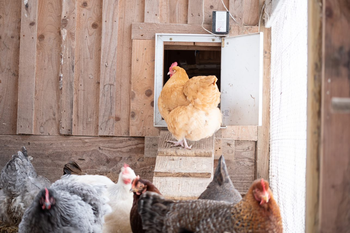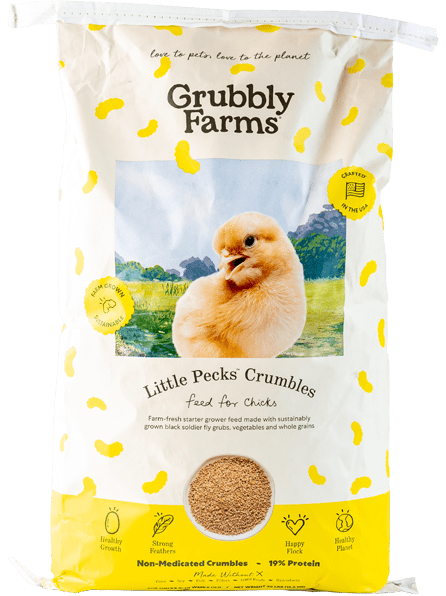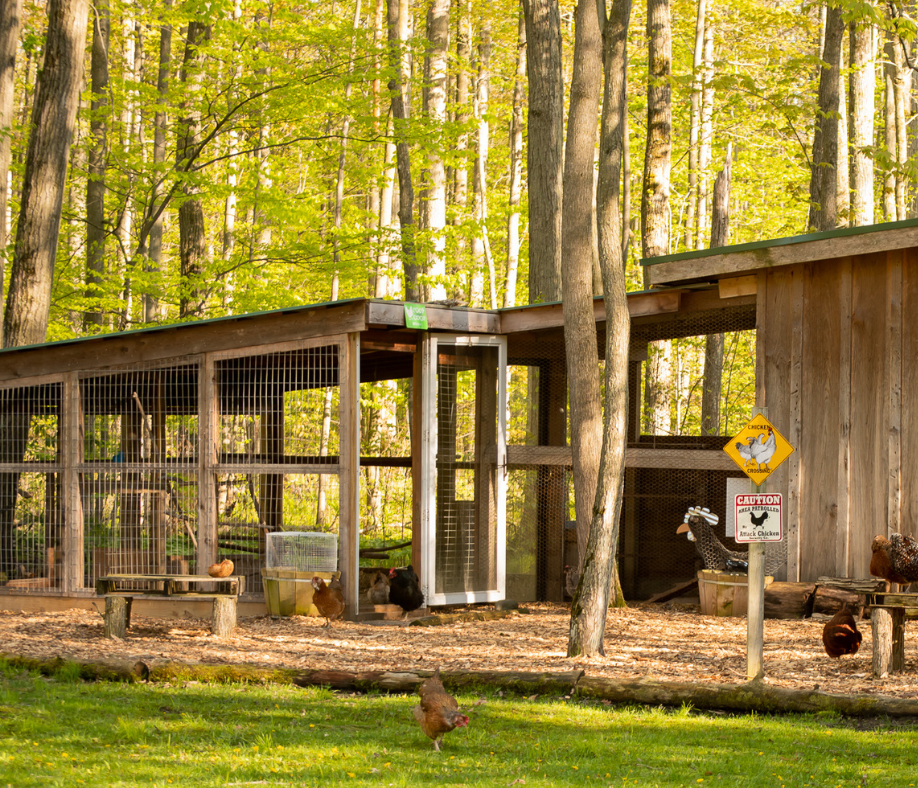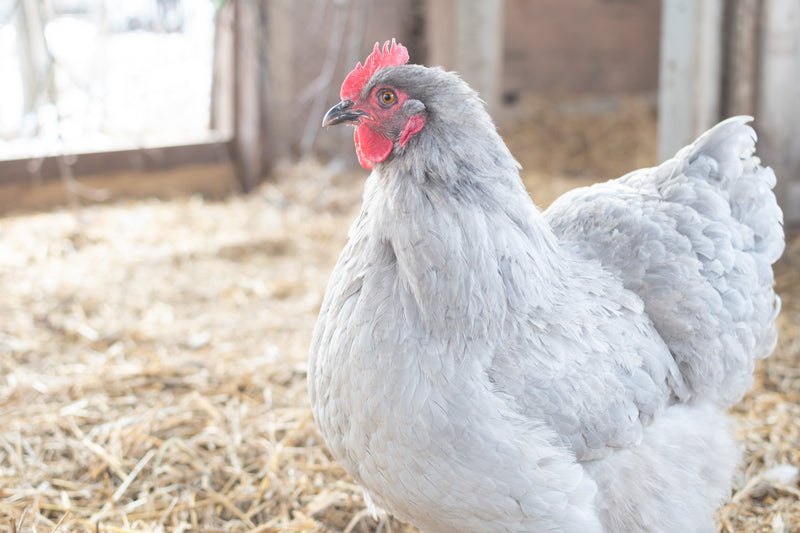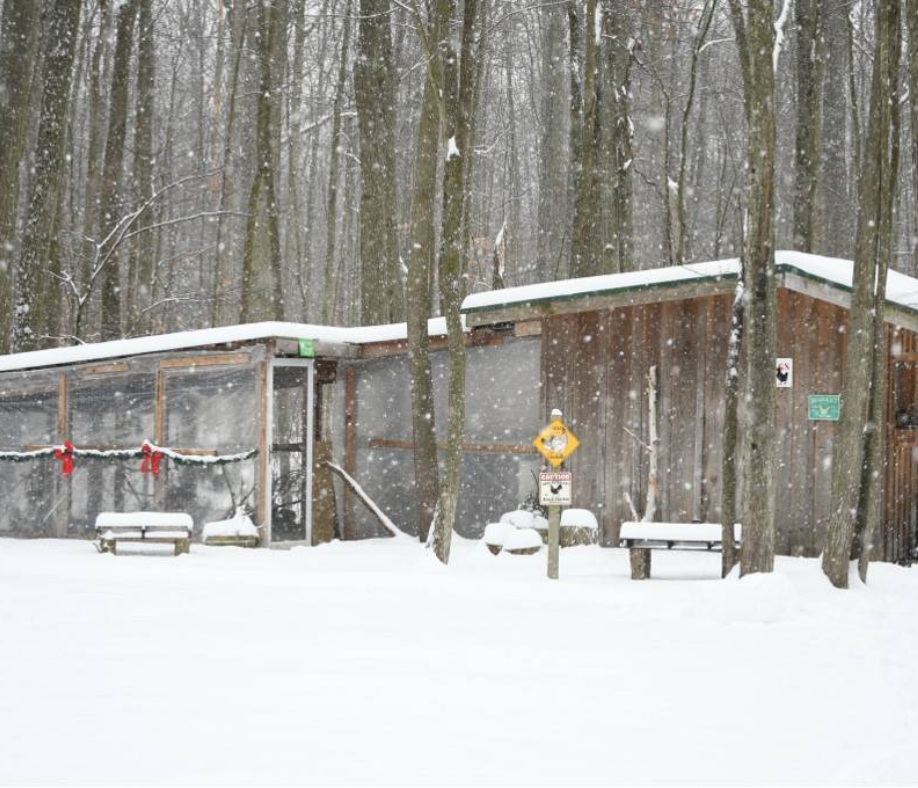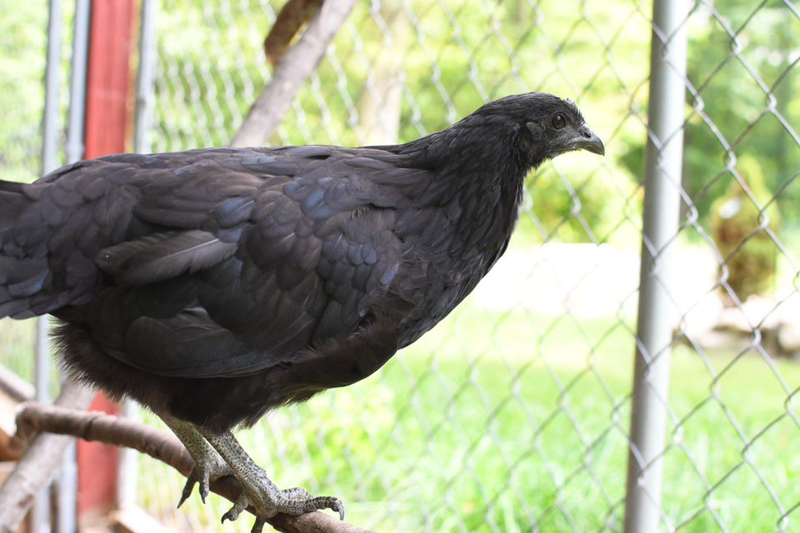Like any animal, chickens need space. This is why one of the most important questions when planning your first chicken coop is, “how big of a chicken coop do I need?” Whether you plan on keeping your flock confined or free-ranging them, your chicken coop needs to be the right size for the number of chickens you are raising (or plan to raise). Even if you are limited by how much property you have or the number of chickens you are allowed to keep, having the right size coop for your flock is essential for keeping them happy, healthy and preventing bad behaviors.
Unsure of where to begin? We will cover how much space you need in your chicken coop and chicken run. Plus, we’ll give you some insight into how to plan for the spatial needs of Bantams.
Why Coop Size Matters

Coop size isn’t just about shelter. Providing a healthy amount of space for each of your flock members improves their overall quality of life. Here is how coop size affects the overall wellbeing of your flock:
Minimizes Stress
Chickens that are not overcrowded in their coop will be less stressed and will be able to establish a more stable pecking order, be more productive, and be happier.
Prevents Bad Behaviors
Overcrowding in the chicken coop can lead to bad behaviors such as bullying, feather pulling, egg eating (improper number of nesting boxes), and sleeping in the nesting boxes (not enough roosting space).
Healthier Chickens
Having enough space in the chicken coop can help prevent bad bacteria and harmful microorganisms from building up and causing disease. Plenty of space can also prevent parasites from spreading throughout your flock.
Keeps the Coop Cleaner
A spacious coop will be easier to keep clean and will minimize droppings build-up which can lead to a stinky, unhealthy coop environment.
How Much Room Do Chickens Need?

There are various factors to take into account when determining the size of your coop. From size to lifestyle, there is rarely a one-size-fits-all approach. The best approach is often to make a list of your flock size, breeds, notes on your climate, city or county ordinances, and available space to build. From there, you can more easily hone in on the best size for your flock using this article.
How Big of a Chicken Coop Do I Need in Relation to My Flock Size?
Chickens will thrive when they are given as much space as possible! However, building a chicken coop mansion is not always possible. There is some good news though! Chickens can still be happy and content when you follow some general guidelines for allowing a certain amount of space per bird in your coop plan.
Coop Space vs. Chicken Run Size
Allowing plenty of space in the chicken coop for each chicken is important, however, the enclosure space is also just as important! Chickens will spend the majority of their time outside when given the chance, so providing your flock with plenty of outdoor enclosure space is almost more important than plenty of coop space.
Enclosure Specifications
You may find that your flock spends more time in their enclosure than they do in the actual chicken coop. Having a spacious enclosure that is bigger than the bare minimum that you need is important for all the same reasons as having a big enough coop.
When figuring out how much enclosure space you need for your flock, you will want to consider factors such as covering the enclosure and including enrichment in the enclosure.
Enrichment
Enrichment items such as perches, ramps, tunnels, logs, stumps, and ladders will all take up space, but they can also increase the enclosure’s vertical space as well. Adding enrichment to the enclosure can help keep your flock stimulated and entertained in the enclosure space that they are provided.
Protection from the Elements
Covering the enclosure will not only protect your flock from predators and weather elements, but it also allows the enclosure to be used year-round and every day by your flock. This can be extremely helpful if your coop space is at a minimum and you can’t free-range your flock. A covered enclosure is basically like an extension of the chicken coop.
Coop Specifications
Your girls will spend their nights in the coop. They will also use the nesting boxes throughout the day, and you may find some of your gals like to frequent the coop for a little alone time.
Roosting & Nesting Space in the Coop
Aside from floor space in the chicken coop, you will also want to plan out enough roosting space and enough nesting boxes in the chicken coop for your flock. Consider whether feeders, waterers, or nesting boxes will take up any floor space in the chicken coop and factor that into your final coop size as well.
Here are some general guidelines for roost and nesting box space requirements:
- Roosts (standard chickens breeds): 8” per chicken
- Roosts (heavy chicken breeds): 12” per chicken, no more than 1-2 feet high
- Nesting Boxes (standard chicken breeds): 12” x 12” x 18”, 1 nesting box per 4 to 5 hens
- Nesting Boxes (heavy chicken breeds): 14” x 14” x 20”, 1 nesting box per 4 to 5 hens
General Coop Size Guidelines Based on Flock Size
You can then figure out how big of a chicken coop you need based on what breeds you plan to raise and how many chickens you want to have in your flock. However, to make the math a little easier, we have figured out some minimum space requirements for a few general flock sizes:
-
How big of a chicken coop for 6 chickens: 24 sq. ft. coop, 48 sq. ft. minimum run space
- How big of a chicken coop for 10 chickens: 40 sq. ft. coop, 80 sq. ft. minimum run space
- How big of a chicken coop for 20 chickens: 80 sq. ft. coop, 160 sq. ft. minimum run space
These guidelines are based on the space needs for a standard-size chicken. If you are raising standard heavy breed chickens, you will need to add an additional 4 square feet of coop space per bird and an additional 7 square feet of run space per bird.
Remember, these guidelines are just minimums! If you can go bigger with either your chicken coop or the enclosure, by all means do so. Your flock will thank you for the extra space!
Still Planning Your Flock?
Is your flock size not listed? Don’t worry, the math is simple! Just multiply the number of chickens you plan to keep by the correct square feet space guideline for heavy or light breed chickens. You will want to figure out both the coop space and the enclosure space based on the size of your flock.
How Much Space Does Each Chicken Need?

Chickens are flock animals and need to be surrounded by other chickens to stay stimulated, feel secure, and be happy. However, you don’t want to just consider how much room your chickens need based on flock size alone. Even though chickens need to be around each other, they also need enough individual space for everyone to get along well.
You will need to plan a coop that will accommodate the size flock you plan to raise.
So, how much room does a chicken need? As much room as you can give it! But ultimately, that’s not practical when building a chicken coop for your flock.
Keep in mind that your county, parish, or city may have guidelines for the minimum space required per chicken.
General Space Guidelines Per Chicken
Here are some general space guidelines for your chicken coop and the chicken coop enclosure or run:
- Standard Breed Chickens: 4 square feet of coop space per bird; 8 square feet of run space per bird
- Standard Heavy Breed Chickens: 8 square feet of coop space per bird; 15 square feet of run space per bird
Determining a Coop Size for Bantams
Bantams are basically miniature chickens that are a quarter to a fifth the size of a standard size chicken. Given their smaller size, bantams are popular for backyards where limited space is an issue. Bantams can have a smaller coop and enclosure than standard-size chickens, but they still appreciate as much space as you can give them!
Here are some general space guidelines for designing a chicken coop for bantams:
- Coop Space: 2 square feet per bird
- Run Space: 5 square feet per bird (minimum)
- Roosts: 6" per bird
- Nesting Boxes: 12" x 10” x 10”, 1 nesting box per 4 to 5 bantam hens
If you raise both bantams and standard chickens together, it is okay to base the coop space needs, roosts, and nesting boxes on standard-size chickens.
Factoring Your Chickens’ Unique Needs into Coop Planning

How much space a chicken needs depends on the chicken’s breed. There are two general size categories of chickens, standard-size chickens, and bantam chickens. Bantam chickens are the smallest chicken breeds. Standard-size chickens are larger than bantams and can be further categorized into weight categories such as heavy breeds and light breeds.
For obvious reasons, bantam chickens will need less space than standard chickens. And heavy standard chickens will need more space than light standard chickens.
We recommend keeping the size in proportion to your chickens’ full-grown weight. When you have a mixed flock, it is a good idea to plan the coop size based on the largest chicken breed you plan to raise.
Lifestyle, Temperaments, & Coop Size
How much space a chicken needs will also depend on how you plan to raise your flock. If your flock needs to stay confined for the majority of their day (or all day), then you will need a larger coop versus if you plan on free-ranging your flock.
Factoring Chicken Breed & Temperament into Coop Size
Another factor that plays a role in how much room a chicken needs in the chicken coop include a chicken breeds temperament. Chicken breeds that have a more assertive and active temperament will need more space to prevent bullying and feather pulling.
Big Personalities = More Personal Space
Standard light-breed chickens tend to be smaller and their temperaments are more assertive and active, so they benefit from more space. Most standard light chicken breeds will fall into the space guidelines for a standard breed chicken.
Big Girls Need Extra Space
Even though heavy-breed chickens tend to have laid-back, less active temperaments, they still need more space given their large size. A few heavy-size standard breed chickens include Jersey Giants, Orpingtons, Brahmas, and Cochins.
Some assertive and larger breeds that will need a bit more personal space per chicken include:
- Old English Games
- Modern Games
- Wyandottes
- Sumatras
- Faverolles
- Asils
- Jersey Giants
- Orpingtons
- Brahmas
- Cochins
Considering Climate in Coop-Size Planning
Regional weather conditions and climate can play a major role in how much run space and coop space your flock needs. Consider your region’s weather patterns as well when determining the covered space for your chickens.
Colder Climates
If you live in northern regions where the winter weather may cause your flock to be confined for extended periods of time, you will want to plan on having a large enough coop to provide your flock with plenty of indoor space.
Hot & Dry Climates
For regions that experience extremely hot weather, a large coop with a higher ceiling can aid with aid flow and keep the coop cool.
Inclement Weather: Storms, Hurricanes, & Ice
In regions that experience inclement weather frequently, having a large coop can allow your flock plenty of space even when they have to be cooped up inside due to the weather.
Why Bigger is Better for Your First Coop

When planning your chicken coop, you always want to plan out a bigger coop than what you actually need. Chicken math is real, and you may find yourself adding to your flock after a year or two of raising chickens. Planning out a larger coop than what you initially need will prevent you from having to get another chicken coop or trying to add on an addition to your existing coop.
Better Overall Chicken Wellbeing
Even if you are restricted with how many chickens you are allowed to keep in your flock, having as big of a coop as possible will help keep your chickens happy and healthy. A chicken coop that is not big enough for the number of chickens living in it can lead to some serious flock issues.
Coop Size Pro Tip: Plan Ahead & Build or Buy Once

Whether you are planning on building a chicken coop for your backyard flock or are looking at buying a chicken coop, first figure out how much coop space you will need for the size of your flock. Always plan on investing in a bigger chicken coop than you need.
Chickens appreciate as much space as they are given, and you never know when you might be adding to the flock! Keeping these general space requirements for chickens in mind when you are designing the chicken coop will help you prepare a proper size coop and enclosure for a happy and healthy backyard flock!





